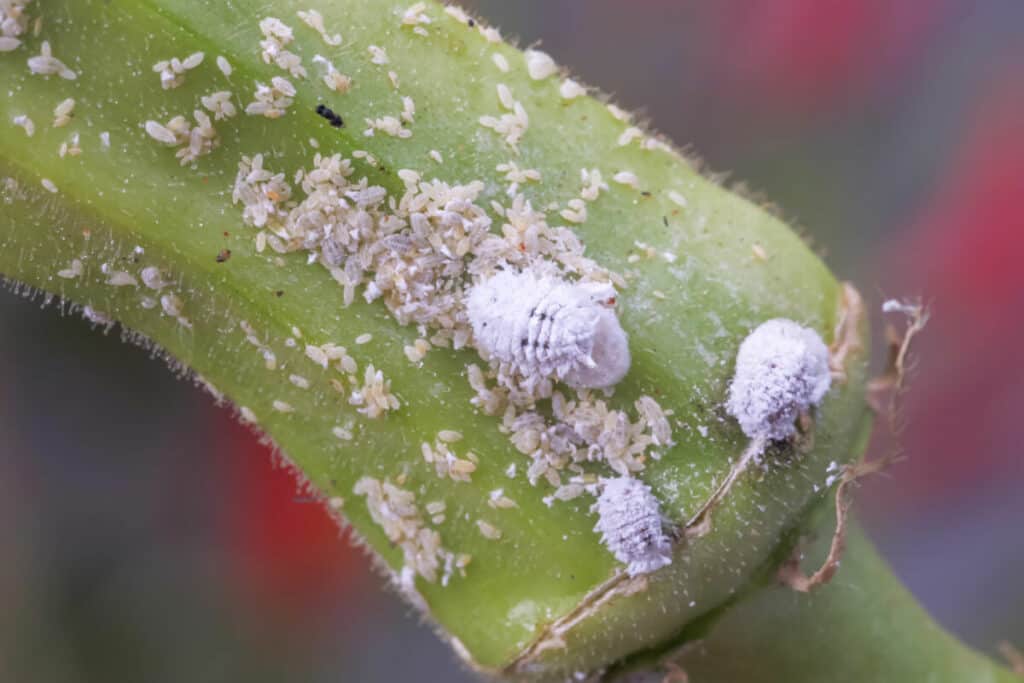We commonly find mealybugs on vegetable plants.
These pests extract sap from vegetable leaves, resulting in wilting or yellowing. They can multiply quickly and attack the entire plant, not just the leaves.
This article will discuss how to identify mealybugs on your plants and provide steps to eliminate them.
What are mealybugs?
Mealybugs are small, soft-bodied insects that are usually covered in a powdery, white wax. They have a rounded body shape with a segmented abdomen and short legs.
Mealybugs are known for their ability to infest plants and feed on their sap, causing damage to the leaves and stems. They also produce honeydew, a sticky substance that can attract ants and promote the growth of sooty mold.
What damage do mealybugs cause on plants?
Mealybugs extract sap from the leaves of plants. You may observe the leaves wilting or changing color to yellow. If the problem is not addressed, the plant will experience stunted growth and eventually perish.
Mealybugs have a white, powdery appearance. They reproduce quickly and release honeydew, which attracts ants and facilitates the growth of sooty mold.
How to identify mealybugs on plants

Look for white, waxy secretions on the stems and leaves to identify the pest. Mealybugs, tiny insects that feed on plant sap, often leave behind these telltale signs.
These secretions, known as mealybug wax, serve as a protective layer for the insects. We can find them in clusters resembling cotton or fluffy white powder.
You’ll find sticky residue called honeydew on plant leaves with mealybugs. Mealybug infestations on plant leaves produce honeydew, which ants love and will flock to your plants.
Read more:
How to get rid of mealybugs
Insecticidal Soap: is a solution that is known for its effectiveness in eliminating mealybugs. It achieves this by suffocating the bugs and disrupting their cell membranes. The product is suitable for use on most plants and can be applied directly to the affected areas.
Neem oil: is effective in eliminating mealybugs as it affects their feeding, growth, and reproduction. To achieve the best outcomes, I suggest using the product as a spray and reapply it every 7-14 days.
Ladybugs or lacewings: can be introduced into the garden to control infestations, as these beneficial insects feed on mealybugs.
Read more:
How to prevent mealybugs on plants
There may be limited effective methods available to prevent mealybugs on plants. It is common to encounter these pests on certain vegetable plants at some point.
I recommend to regularly monitor your plants. It is important to be aware of mealybug infestations on plants so that you can promptly address and eliminate them.
Host vegetable plants for mealybugs
I have seen them on my tomato and pepper plants. But we can find mealybugs on any plant in the garden, as they feed on the sap from the leaves..
Natural predators of mealybugs
Ladybugs and lacewings are natural predators of mealybugs, which can help control their population in gardens.
A diverse range of plants can attract them to your garden, so planting a variety of flowers and herbs can help attract and maintain their presence.
References
- https://en.wikipedia.org/wiki/Mealybug
- https://ipm.ucanr.edu/PMG/PESTNOTES/pn74174.html
- https://ncipm.icar.gov.in/NCIPMPDFs/Publication/BulletinMealybugsEnglish.pdf

Fact Checked, Written, and Published by Kevin Rodrigues
Kevin is the founder of Gardening Mentor, a website that aims to teach people to grow their own food in a limited space. As a self-taught gardener, Kevin has spent several years growing plants and creating gardening content on the website. He is certified in Home Horticulture and Organic Gardening from Oregon State University. He has a Post Graduate Diploma in Horticulture and Landscape Gardening from Mumbai University.
Read more
